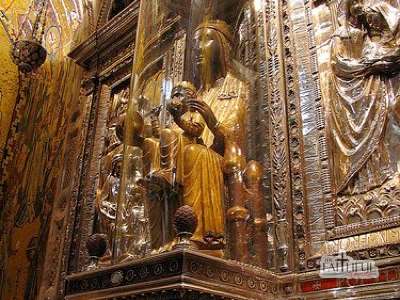 I recently discovered The Blog of the Courtier, a blog written by William Newton, a self-described “thirty-something, practicing Catholic, attorney and unreformed flâneur living in Washington D.C.” (FYI— flâneur if a French term for a stroller, lounger, saunterer, or loafer.)
I recently discovered The Blog of the Courtier, a blog written by William Newton, a self-described “thirty-something, practicing Catholic, attorney and unreformed flâneur living in Washington D.C.” (FYI— flâneur if a French term for a stroller, lounger, saunterer, or loafer.)
Today, he has a lovely post about yesterday’s feast of Our Lady of Montserrat, the Patroness of Catalonia. Definitely check it out, but here’s a snippet:
Montserrat is both a mountain and an abbey significant not only to Catalonia, but is a treasure of Western cultural history. It has witnessed an enormous number of significant events, and been associated with figures as diverse as the redoubtable Julius II, who was honorary abbot and sponsored some of the building projects, visits from numerous saints such as St. Aloysius Gonzaga and St. Vincent Ferrer, and both the Holy Roman Emperor Charles V and his son King Philip II of Spain died holding blessed candles from Montserrat in their hands.
The mountain itself is a geographic anomaly: a gigantic hunk of rock about 4,000 feet high sitting in a plain, all by itself, about an hour’s drive from Barcelona. Because of its serrated peaks, it was named “Montserrat” or “saw-toothed mountain” by the locals. Its coat of arms features an outline of the mountain being cut with a saw, often supported on either end by two angels acting as celestial lumberjacks. It was associated in the Middle Ages with Parsifal’s search for the Holy Grail in the legends of King Arthur, which was kept in a mountaintop castle called Montsalvat, so much so that Wagner set his opera “Parsifal” there.
Atop the mountain is the Benedictine Abbey of Our Lady of Montserrat. There are a number of legends surrounding its foundation, dating back to the 800’s, when a miraculous image of Our Lady was discovered, supposedly sculpted by St. Luke and hidden here during one of the Moorish raids. Four chapels (of which only one now remains) were known to have been built during that time, though there were hermitages all over the mountain peaks. However, the official founding of the monastic community occurred in 1025 with the permission of the Bishop of Vic, in whose diocese Montserrat stands.
David and I were blessed to visit Montserrat in 2006, when we spent a week in Barcelona. I was looking through my photos, and it seems I didn’t take any pictures of the visit. They must not have allowed them, otherwise I’m sure I would have.
I remember the day was a bit foggy and overcast. We looked around during the brief time we had there and got to kiss La Morenita. Before our bus left, I got the most delicious snacks at the cafeteria—jamón, queso, y aceitunas (ham, cheese, and olives)—which we enjoyed on the way home.
I definitely want to go back, but next time, not on a bus tour. I don’t like being forced to come and go when someone else tells me to, you know? Montserrat is a place you need to linger, to stay and pray and be in awe of God’s love for us.
I highly recommend you visit La Morenita next time you’re in Barcelona, one of my favorite cities.

